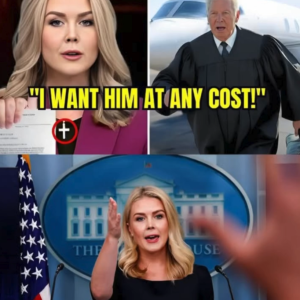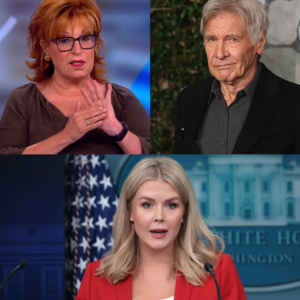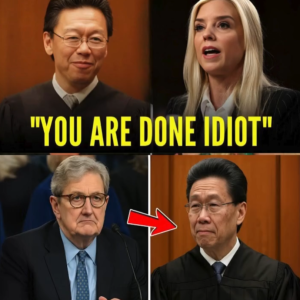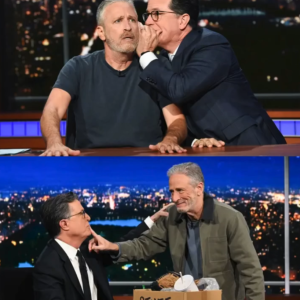The rumor didn’t arrive with a press release or a headline splashed across the networks.
It moved like static electricity through the undercurrent of an exhausted industry, an almost imperceptible charge that made people’s voices drop and their eyes dart toward closed doors.
Somewhere in the tangled backrooms of American television, two people—two figures so different they might as well have lived on opposite ends of the broadcast spectrum—were said to be in the same room, speaking the same language, plotting the same future.
Jon Stewart.
Lesley Stahl.
To hear those names together in the same breath was to feel the floor shift underfoot.
One, the satirist who made presidents wince and media moguls squirm, a man who weaponized humor with surgical precision until the truth was the only thing left standing.
The other, a monument carved from the granite of network news, who had stared down kings, dictators, and CEOs with that unflinching gaze that could make even the most rehearsed talking points crumble.
They had never worked together.
They had never needed to.
Yet now, whispers claimed, they were preparing for the boldest handshake of their careers.
And in a climate where trust in media had been reduced to rubble, it wasn’t just gossip—it felt like a declaration of war.
The airwaves in 2025 were a battlefield littered with the debris of partisanship and performative outrage.
Channel after channel pumped out conflict disguised as conversation, algorithm-friendly rage masquerading as reporting.
Most people didn’t feel informed; they felt manipulated.
Institutions, once anchored in public trust, floated in a haze of corporate self-preservation and hollow spectacle.
And into this wasteland came the suggestion—small, almost absurd—that a satirist and a stateswoman of journalism could be the ones to rescue it.
For Jon Stewart, the crown of political satire had always been too heavy to wear comfortably.
From his desk at The Daily Show, he didn’t just mock the absurdities of the day—he dismantled them, exposing the theater for what it was.
Politicians who coasted on platitudes found themselves skewered with a single raised eyebrow.
Media outlets hiding behind faux objectivity watched their facades collapse under a perfectly timed punchline.
For an entire generation, Stewart wasn’t just a comedian; he was the only voice that felt like it wasn’t lying.
When he walked away, it was like a light going out.
The news felt emptier, the absurdities sharper without someone to point at them and laugh.
And when he returned in 2025, the laughs were still there—but there was something different in his eyes.
The edges of his jokes cut deeper, as if he no longer found the chaos amusing.
It was the look of a man who had decided mocking the kingdom wasn’t enough.
Now, he wanted to fix it.
In another orbit entirely stood Lesley Stahl, fifty years of broadcast journalism etched into her every word and gesture.
Her presence was synonymous with credibility—the kind you couldn’t buy, couldn’t fake, couldn’t algorithm into existence.
If Stewart had been the outsider throwing stones at the gates, Stahl was the gatekeeper who had spent decades inside the palace.
She knew every corridor, every secret, every compromise made in the name of “access” or “balance.”
Which is why her rumored turn was so stunning.
Reports whispered of her growing disgust with the industry she helped define, of conversations behind closed doors about the corporate sedation of public discourse—a system built to keep citizens calm, distracted, and consuming, not questioning.
This wasn’t nostalgia for the good old days.
It was a willingness to burn the playbook she’d once enforced.
Put them together and it didn’t feel like a collaboration.
It felt like a controlled detonation.
He brings the fire, the trust of a deeply skeptical public, the ability to translate complexity into something you couldn’t look away from.
She brings the gravitas, the institutional muscle, the receipts from decades inside the machine.
He knows how to connect.
She knows where the bodies are buried.
And the industry knows—whether it admits it or not—that a Stewart–Stahl alliance could bulldoze the primetime model.
Networks like CBS, CNN, and MSNBC live on the predictable drip of conflict-as-entertainment, panel debates designed to produce more heat than light.
But the rumors painted a different picture: a program blending 60 Minutes-style investigations with the raw immediacy of Stewart’s interactive town halls.
Not a segment.
Not a skit.
A sustained excavation of truth, carried out with the dual force of wit and rigor.
The first detail that allegedly leaked was enough to make newsrooms freeze mid-sentence: long-form deep dives that didn’t just host “both sides” but dismantled the false equivalence between them, replacing it with a genuine hunt for the facts.
The kind of journalism that might make a senator refuse the booking—not because they feared bias, but because they feared honesty.
For Stewart, the challenge is personal.
The man who made cynicism a national coping mechanism would have to shed enough of it to guide people through the fog instead of just pointing it out.
But we’ve seen this side of him before.
His advocacy for 9/11 first responders wasn’t played for laughs—it was pure conviction, the kind that makes your throat tighten.
It was the moment the jester put down the bauble and picked up a sword.
Partnering with Stahl would mean living in that space permanently.
For Stahl, the risk cuts just as deep.
To align with Stewart is to step outside the granite walls she’s lived within, to abandon the illusion that the system can be saved from the inside.
It’s a move that would invite scorn from her peers and suspicion from those who’ve spent years writing Stewart off as “just a comedian.”
Yet the calculation is clear: with the stakes as high as they are, the polite conventions of the establishment are no longer an asset—they’re a liability.
What’s emerging isn’t just a new show.
It’s an entirely different proposition for how Americans might consume information: a place where facts aren’t softened for advertisers, where interviews aren’t scripted for ratings, where the public’s time isn’t spent as a commodity to be mined.
In an environment designed to divide and distract, such a platform would be both radical and, in its own way, dangerously simple.
Already, the speculation has stirred unease in certain boardrooms.
Executives who’ve built fortunes on predictable programming know that unpredictability is the one thing audiences still crave—and the one thing they can’t control.
A Stewart–Stahl venture would be a wildcard they couldn’t buy, bully, or bury without looking exactly like the villains they pretend not to be.
Social media hasn’t helped.
The mere whisper of the alliance has triggered fevered threads, split-screen memes, and breathless commentary from corners of the internet that haven’t agreed on anything in years.
The hashtag #StewartStahl trended for hours without either of them confirming a single detail.
Some called it the dawn of a new public square.
Others called it a fantasy.
Everyone agreed on one thing: if it happened, the aftershocks would be impossible to contain.
And maybe that’s the point.
Because whether it’s born of frustration, idealism, or sheer defiance, this rumored project forces a question the media has been avoiding for years: what happens when the people who’ve seen the system from both sides decide they’ve had enough?
What happens when the man who makes power sweat and the woman who makes it confess decide to aim at the same target?
Somewhere, behind a door we can’t yet see, those conversations may already be happening.
Somewhere, two people may be sketching the outlines of something that could either save the truth or put it in more danger than ever.
And when the first broadcast comes—if it comes—it won’t just be another entry in the nightly lineup.
It will be a test.
Of the audience’s hunger for honesty.
Of the establishment’s tolerance for being challenged.
Of whether the truth can survive not as a soundbite, but as a sustained, unflinching conversation.
In that moment, the ratings won’t matter.
The sponsors won’t matter.
The only thing that will matter is whether, for the first time in a long time, the people watching will believe what they hear.
Until then, the rumor hums on—low, steady, and getting louder.
The kind of sound that tells you something’s coming.
Something big.
Something the media might not be ready for, but the country can’t afford to miss.
If they do it, it won’t be television as usual. It will be something else entirely—and the system will never be the same.
The contents of this article are compiled based on a convergence of internal briefings, behavioral records, contemporaneous documentation, and public-facing developments. Contextual alignment of events is presented to reflect evolving corporate dynamics as interpreted through direct access and secondary insights.





